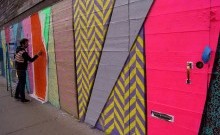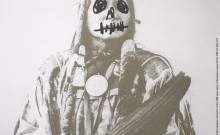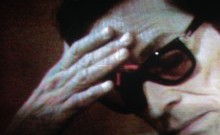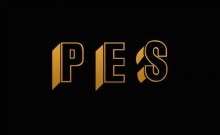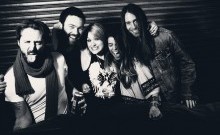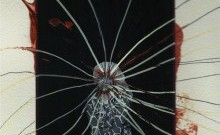Fine Lines (with Bryndon Everett)
I (probably) know Bryndon Everett better than I know anyone else I've never met before. For the last year and half or so, Bryndon and I have been working on a project together, a graphic novel for which I wrote the story and he brought it all to life, with vivid and technically awesome illustration. When I met Bryndon (to potentially do the project), I was told a few things about his skills: That his hands and faces were incredible, and that he worked hard and fast, was easy to get along with, and was someone who was clearly on the rise within the comic world and industry. All of these things proved to be true. As did a lot of other things about Bryndon and working with him. Yes he works fast and reliably and his lines are clean and slick, consistent, and beautiful. He draws cinematically, and his perspective, action, and character design flawless. He's ambitious with angles and ideas, and his love of movies (and great ones) are evident in his work. He is a great collaborator, an inspiration to work with, and someone I'm thrilled to be able to share with an audience here at o.n.e.f. (1985).
In the last interview I did here, Marisa P. from Straight Up offered some pretty sage advice: "The secret to success is actually showing up. Because the majority of people don't." I think about that good and relevant advice, relevant to the arts and other professions, relevant to work and other things one endeavors to excel at. Bryndon Everett shows up.
It's rare in this world that you don't need to worry about the people you work with (for me at least, and aside from the artists on this site, + a few other exceptions of course). Insert your terrible project story(ies) about the person(eople) you've hated working with the most here. This is not one of those stories.
JM: I know this year's been pretty busy and full of new ventures for you? What kinds of things have you been working on; and what are you working on now?
BE: First of all, thank you for the opportunity to do this. I'm sorry in advance for what will undoubtedly be long-winded, William Henry Harrison level rants, masquerading as responses. I don't really get out or talk to people much. So let's dig in. Where were we? My year, right. This year's been a roller coaster. I went from rock-bottom to (relatively) lofty heights in a matter of months. By lofty heights, I mean I'm at a level that I feel okay splurging on a couple of comic books a month --- a huge indulgence for me. The variety of things I've been working on this year has been wild; I've had a few freelance gigs, including the amazing opportunity to work heavily with The American Dream Labs. In the last 6 months alone, I've done concept art, illustration, animation for a quick turn-around commercial, logo design, graffiti commissions, and of course, comics. I just wrapped the artwork on Shogun Rising (the graphic novel we've been working on for most of the last year), and already have a couple other comic gigs lined up. I'm not used to having things pipelined so well, so it's wild right now. And like this minute, I'm doing comics, and only comics. I'd be fine doing that for the rest of my life, but opportunities are always popping up, so who knows.
JM: Sounds amazing. How do most of your projects (or assignments) come together?
BE: I really pride myself on my work-ethic, being easy to work with, and my fast turn around times. I'm never going to be known as the best artist alive, but I don't have to be. I just try to maintain a reputation of being the hardest working, most easy-going artist, and word gets around. A lot of the work I'm doing now, however, and this is deadly serious, I owe either directly, or through like one degree of separation, to people finding me on Instagram. Hooray for the internet!
JM: Any new projects in the works that you can talk about?
BE: I'm slated to work with Magnetic Press later this year. Everything they produce is made of amazing, so I'm really excited about that. I have a few projects that I can't talk about, but I also have a few personal comics going. My main project is "Adrift," a serial comic idea. It started out as just catharsis, a way to clear my head after finishing a block of pages on Shogun Rising . As I got into it, it became a short, 10-or-so page one off, that has now grown so big I'm thinking of putting it online as a series. I'd also be interested in publishing it traditionally, but who knows. Like a lot of artists, I've got a lot of stories and other work sitting around half illustrated, and waiting in the wings. I also have a novel I'm writing, with a publisher all lined up, if I could just find the time...
JM: What's the timeline on that stuff?
BE: No timelines on any of the personal work. I'd like to get Adrift out in one way or another, this year. And Shogun Rising, you tell me...
JM: Pretty soon man (I hope). What kind of artist do you call yourself: Illustrator? Story teller? Graphic Artist? Art Director?
BE: I dunno. A hard working one, I guess. An obsessive, skinny, pale, bearded, under-rested, over-involved one? Ha-ha. I usually just call myself an illustrator. That pretty much covers the bases. That said, I do take special pride in getting to refer to myself as a professional Comic-Artist.

JM: How would you describe your style(s)?
BE: Oh man. Is there any way to answer this without sounding like a complete douche? I don't really describe it at all. But I guess if I have to: Graphic meets Classical, with a HEAVY influence of Comic Book? As a guy who's obsessed with movies, and appreciates unique, original filmmaking, I like to try to capture a cinematic feel with my work, and the way I frame things out. I don't know that I'm any good at it, but that's what I try to do.
JM: Anything you can't draw?
BE: Honestly, I can't draw cars or horses. I mean, I can, but never to a point where I'm satisfied with 'em. It's kind of ironic, because I have a deep passionate love of cars, and auto racing...Go figure.
JM: Seemed like the horses you drew for "Shogun Rising" worked out pretty well.
BE: Yeah, like I said, I CAN draw them, I just feel like I need to work on it. I think every artist has something they know they could do better, and that just happens to be mine.
JM: Tell us a little bit more about your upcoming books ("Shogun Rising" and your personal ones)?
BE: Well, "Shogun Rising" is a Samurai/Zombie mash-up, as you know, with a healthy dose of Romeo & Juliet served in. It's set in the mountains outside modern Tokyo. It's got a lot of elements at play, and explores a lot of cool themes and archetypes. I hope it'll make people think, you know? How far would you go, and what would you sacrifice for love? It's been a tough project, but I'm really proud of the work we've done on it and I'm really excited to see how it goes over. My current personal comic, "Adrift," I wanna' keep close to the vest, until I figure out how I want to get it out there exactly, but it's a story about an adolescent girl, who finds herself in a frightening situation and a setting with which she's unfamiliar, and how she responds to that. It's a really surreal, creature-heavy story of adaptation and survival, and I'm really excited about it. My novel, is a kind of psychological thriller. I've got a few chapters written, and a publisher lined up, so I'm just gonna' keep that one to myself for now. Beyond that, I have a Noir comic completely written and half-drawn, a story that explores theology planned out, My wife and I are writing together, and I even have a Batman story written. That'll never get made, because DC would shoot me down fast for making things WAY too dark. Hopefully we'll get into Shogun II soon.
JM: Already working on it. --- How would you describe your style, or aesthetic voice? What, in everything you do, “says” this is Bryndon Everett's work?
BE: Dammit, another question that's impossible to answer without coming off like a self-worshiping, ego-maniac. I thought we were friends, chief...
Alright, here goes: I'd like to think cool perspectives and unique designs, often with a somewhat punk influence from a misspent youth (that cost me the cartilage in my nose, a tooth or two, and the higher registers of my hearing); but the truth is, I'm really not sure. I feel like my style is evolving as I grow as an artist. There are actually a few pages inShogun Rising that we did a year-or-so ago, to which we added some panels last month, and when you look at them side-by-side, it almost looks like a different artist drew them. It's good though. I think the worst thing an artist can do is stay stagnant.
JM: Take us through a typical day in the life.
BE: Okay, this is no joke. I am like an obsessive, Victorian scientist when I work. Just a borderline lunatic. Depending on how slammed I am, my day starts at around 9 am. I wake up, stagger into my office, and turn on my computers. 3 of 'em. Sometimes while they're powering up, I'll get some cereal, then I'll be there, working until around 2 pm when my wife comes home for lunch. I'll hang out with her for an hour, then it's straight back to it. I'll work until 6-7 when the wife gets home, hang with her until 9, then back to work until 3-4 am. Then I'll go to bed to start over again. So, that's anywhere from a 12 - sometimes 16 hour day, at my desk, working... really seven days a week. If I've got more work, I'll skip the evening breaks, and work straight through. Just to break things up, and try to stay somewhat human, every time I get up from my desk, I'll do 30 push-ups, and do 5 finger-tip chin-ups on my office door frame before I leave. I've been trying (rather unsuccessfully) to cut my hours back, and spend more time just being human, and alive. I try to get outside at least once a day, (usually ends up once every three days, but who's paying attention) and make more quality time with my wife. She's my whole world, and everything I do is for her. She's a huge support, really creative, and always helps me art direct myself. We're actually writing some really great comics together.

JM: How many of your typical marathon work days does to it take to draw a book? What about if you do the coloring too?
BE: I can get 2-3 pages of a comic penciled in a day, and 2 inked. If I'm coloring, I don't know. It'd take me much longer, like a full day to color, probably. Coloring really isn't my thing. I can do it, I am capable, but It's not my main selling point, and it's still a very experimental thing for me when I do it.
JM: Describe your workspace. What's always within reach and what else is around? How does your working space inspire you?
BE: My workspace is trashed. Whenever I get a chance to clean it, I usually take a picture, and post it to my instagram, and pretend like it's always that way. Like I'm some kind of consummate fastidious professional. Anyway, let's see: The walls are adorned with vintage auto-racing posters, art, B/W Sci-Fi Film posters, and patriotic stuff. Like there's a Winchester Shotgun on my wall, and a gigantic Revolutionary US flag behind me. Within reach are assorted comic-books, art reference and resource books, and various DVD's. It's pretty basic stuff for people in my field I imagine, though I admit, I've never been in anyone else's workspace. So I'm just speculating, like a less-awesome Criswell.
JM: Who/what were your influences?
BE: We have neither the time, nor the space, to list all the artists I find influential, but let's try: Calum Alexander Watt, Joshua Middleton, Bengal, Ramon Parez, Greg Toccini, Gianmarco Magnani, Stuart Imonen, René Gruau, J.C. Layendecker, Doc Hammer, Jessica Cooper, Vincent Giarrano, Horia and Daniel Dociu, Mike Mignola, Otto Schmidt, Jerad Marantz, Sara Pichelli, Mateo De Longis, Cameron Stweart, Kevin Chen, Wesley Burt, Sergi Brosa, Andrew Domachowski, Andrew C. Robinson, Nate Simpson, Cheeks Galloway....You know what, this could go on, and on, but I'm going to stop myself, and apologize collectively to everyone else I left out.
JM: What else inspires you or helped create your style?
BE: Not having any idea what I'm doing. Seriously, I have very little formal training, so my style comes from emulating other artists. My favorite thing is trying to get the most impact out of as simple of compositions as I can. I use a lot of negative space. I tend to like heavily detailed subjects set against empty backgrounds, and bold colors. I'm also a huge fan of film. Guillermo Del Toro, the films of Edgar Wright, Jean-Pierre Jeunet. My favorite film of all time is The Brothers Bloom. The visual style of that movie has permeated not only my work, but every aspect of my life. I also think Lucky Number Slevin is a crazy, beautiful, and wildly underappreciated film. I've also always been really inspired by dancers. The dedication, the time, and life-sacrifice that takes for such a short lived career. Especially ballet. Those people are crazy. I really admire it, and try to live up to that level of dedication.
JM: Do you listen to music or watch movies when you work or just work?
BE: MOVIES! Most often with Commentary running. I'll watch (listen to) the same movie/commentary over and over again. It goes back to when I was like 18, and in art school for the first time. I had no computer, or internet access, and it was the days before smartphones. But I had a portable DVD player, and like 12 DVD's. I had sold my car to help pay tuition, and only had a skateboard to get around. So I would watch all my DVDs over and over, just for a substitute for company while I did my homework. Full days, covered in charcoal in a room I rented in North Hollywood, watching "FLCL" (video anime series written by Yōji Enokido, directed by Kazuya Tsurumaki), "Hellboy," "The Lord Of The Rings." It was my first taste, really, of what would become the routine of my life and how I work, up to and including today.

"Shogun" Cover Art
JM: Were you always good at drawing, even as a little kid?
BE: I don't know if I'm even good now, just hard-working, and affordable. But I did always have a passion for it. I've never planned, or wanted to do anything else. Art kind of came naturally, but I've always worked hard to be the best I could and can be. Thankfully, I grew up with crazy-supportive parents, who worked hard, and were willing to sacrifice their own dreams to provide the opportunity for their kids to follow theirs, and they loved it when we did. But nothing good comes without effort. As a kid, when people would say I was talented, I used to get upset, and tell them "it's not talent, It's acquired skill [from all the hard work I've done]." I still think that's a good way to look at it. I've worked hard to get to where I am, and nothing in this industry's been handed to me. I've really worked my ass off to get to just THIS level of success. Originally, I wanted to do concept art for video games. I got a LOT of rejection from every company I applied to; which was like 100 different companies around the globe. In my desperation, I even offered to work for some of them on probation for free, and still nobody took me. During that whole (pretty sad) time, I was working a series of truly odd, non art related jobs. I was a seasonal farmhand, I dug ditches, moved furniture, replaced septic tanks, did flower delivery, I owned a snow shack, I worked in an agricultural laboratory...a WIDE variety of jobs. After awhile, I landed a job doing graphic design for small potatoes, and began making a comic of my own, which was rejected by publishers. I was rejected by art galleries, rejected by art magazines, rejected by illustration firms and head hunters. Finally, I started getting noticed for my Comic Book Fan Covers on Instagram, and eventually Marc Scheff asked me to illustrate a comic for the guys doing Shogun Rising. Now, here I am.
JM: What was your first paid gig?
BE: That's goin' back. Let's see: I'm pretty sure it was an album cover for a 3rd Wave ska band from Boise, when I was about 15. They paid me $50 and sent me a free CD, and I was sure my career was just going to be all high-roller from there.
JM: How'd it go since then?
BE: In the last 13 years? A lot of ups and downs, man. I don't even know...I mean, I'm thinking about it, and really, things have changed, but even more has stayed the same. Sure, I've grown up a little, and my rates have adjusted, but I'd like to think I'm just as motivated today as I was when I was a pie-eyed (little) punk, eager to prove myself to the art-world.
JM: What's the best and worst thing about Freelancing?
BE: The best thing for sure is the freedom to pursue projects I really believe in, and actually WANT to do. The worst thing is definitely the panic you start to feel when a gig is getting close to the end and you don't have anything pipelined. That warm comforter of steady paychecks gets ripped away, leaving nothing but the cold familiar sheets of anxiety as you wonder if you have enough savings to make it through until you find the next job (whenever that might be). Fortunately, these days, I manage to keep busy. Which kind of segues into a secondary problem: I take all the work I can get, when I can get it, and it leaves me seriously, NO free time to work on my personal stuff, or a social life, or spend time doing anything else, or even see daylight... It's the life I chose, and I love it, but man, thinking though all this, it's giving me a chance to step back and look at it, and if somebody who didn't absolutely love this work were to do it, it'd be gosh-damned depressing.
JM: What's your dream job, specifically? If you could work on anything?
BE: Honestly, I'm doing it. If I could change anything though, I'd really like to have more time to work on my own stuff. That's the dream. It's not a very original answer, but it's true. I would like to just keep making things people enjoy, and keep being paid for it.
JM: What's your favorite thing about art (being an artist)?
BE: Creativity! I love that my career is dreaming up, and making new worlds, creatures, and characters. I also feel like I have a cool perspective on the world because of it. I'll often stop what I'm doing when I'm out to take a reference photo, or shoot some cool texture that I think would look good on Project X, or Y. I have massive computer files of all sorts of reference, and I like that that's a thing in my life. Always looking for inspiration and perspective. Always finding new ideas. I've also found that everybody in the Biz is just CRAZY-nice, and always wanting to help each other and bring new talent into the industry. Every artist I've ever met, or worked with so far, all of them, gladly help people who'll compete with them for jobs later on, but nobody seems to mind --- at least in my experience.
JM: What advice would you give to people first starting out?
BE: Always be working, and never half-ass anything, even your personal doodles. Always make whatever your doing the best you've got, because somebody's going to see it, and judge your quality off of it. Also, it's not just a stupid stereotype, you REALLY have to be able to take rejection well to get anywhere in this business. Like, A LOT of it. Look at what I mentioned above, hundreds of companies rejected me. HUNDREDS! And even today, I send in designs that I LOVE and am convinced the client/Art Director will love, and they get thrown out like Ace Of Base singles. Use that rejection or criticism, or whatever it is, to grow. Learn from it, and let that stuff help you become a better artist. You don't improve when everybody coddles you, and tells you you're all perfect and special. That's not the real world. I constantly, openly invite people to comment on and criticize my work. Honestly, if they're taking the time, there must be something in the imagery they like, and they can tell it just needs that little push to be perfect. I truly appreciate it if someone's willing to take the time to help me improve. So please and always let me know what you think. That goes for your readers as well. If critique and criticism really bother you, commercial art sure as hell isn't the right field for you. Other than that, just keep working hard, keep improving, and the dream projects will eventually come.
Shogun Rising: Facebook | Twitter




